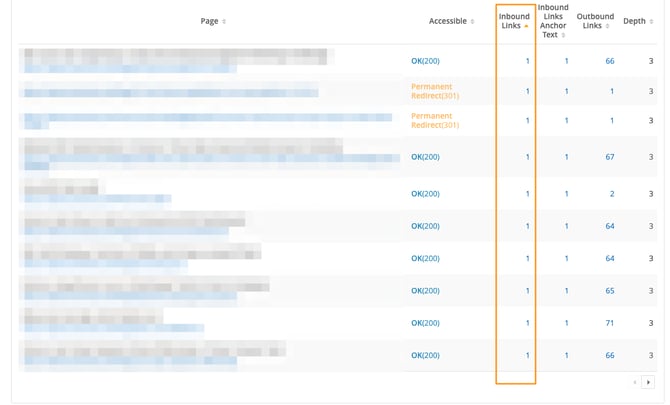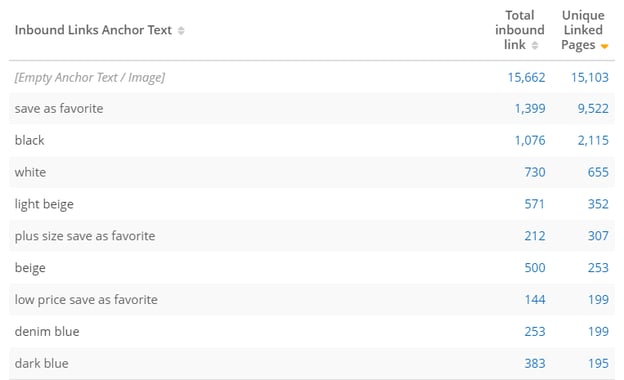Enterprise SEOs face a constant challenge: how to maximize organic performance across massive websites with thousands—or even millions—of pages.While technical optimizations and backlinks get the spotlight, internal linking is often underutilized, leaving valuable ranking opportunities on the table.
The right internal linking strategy can improve crawlability, distribute authority effectively, and enhance user engagement—all leading to stronger rankings and higher conversions. But without a clear plan, internal links can become disorganized, ineffective, or even harmful to SEO.
In this blog, we’ll break down the 7 key benefits of internal linking and how you can leverage them to boost organic visibility, improve site structure, and drive better results.
Here's what we'll cover:
- What Are Internal Links?
- Why Are Internal Links Important for Search Engines?
- 7 Benefits of Internal Links for SEO
What Are Internal Links?
Let's start with a basic definition of internal links:
Internal links are hyperlinks from one of your web pages to another page that lives on the same domain.
They shouldn't be confused with backlinks (also known as external links), which are links that point to your site from another domain. Here's a quick refresher on internal versus external links.
We’ve covered the best practices on how to internally link in a previous blog. The why is where it gets a little more complex.
Why Are Internal Links Important For Search Engines?
Internal links play a crucial role in SEO by helping traditional and AI search engines discover, index, and understand the structure of your website. They also improve user experience by guiding visitors to relevant content, keeping them engaged longer.
As AI search becomes smarter, strong internal linking helps it understand how topics and entities relate across your site, making it easier for the right content to appear in relevant results.
As AI search becomes smarter, strong internal linking helps it understand how topics and entities relate across your site, making it easier for the right content to appear in relevant results.
Of course, internal linking also matters from a technical perspective as the right strategy helps eliminate broken links and redirect loops while building site authority.
Despite some challenges of internal linking, they’re a small but mighty way to strengthen your content marketing program and shouldn't be overlooked.
7 Benefits of Internal Links for SEO
Some of the most notable benefits of internal linking for SEO include:
- Enhanced User Experience
-
Improve Engagement Metrics
-
Drive Users Toward Conversion
-
Build Your Website Architecture
-
Improve Crawl Efficiency
-
Build Your Link Equity
-
Tell Google Which Keyword You Want to Rank
Let's dive into these in more detail.
#1. Enhance the User Experience
Internal links offer your audience the ability to dig deeper and inform themselves more about a specific topic of interest.
Take this example from our own blog. When reading about homepage SEO, the topic of crawlers may come up and you might realize you don't know much about them. Voilà: an internal link gets you to an introductory article on web crawlers.
In our writing, we sometimes apply these internal links as “Recommended Reading” links to clearly tell the reader that there is additional information on our site to help them understand the topic fully. Here's one for you now…
Recommended Reading: Common Internal Linking Mistakes in SEO (and How to Fix Them)
Those connections help your audience build their knowledge on topics they find interesting. If you've ever been down a Wikipedia rabbit hole, you know exactly what we're talking about.
#2. Improve Engagement Metrics
Laying out a clear journey for your audience encourages them to explore your site more deeply and view more pages.
This actively reduces bounce rate and increases time on page — two very important user experience metrics to keep an eye on!
#3. Drive Users Toward Conversion
Building a robust internal link structure enhances user navigation and guides your target audience towards a sale. By strategically linking relevant content, especially from your early funnel stages, you can lead users deeper into the funnel, increasing the likelihood of conversion.
Start by using links on your homepage to direct users to your content marketing pieces. From there, individual blog posts can guide them toward gated content, free trials, or product pages. Just like that, your audience moves from initial awareness all the way to becoming leads and customers.
To create an effective internal link network, analyze your content from the perspective of the buyer's journey. Approach it like content mapping:
- Create the Right Content: Develop content tailored to each stage of the buyer's journey.
- Optimize for Search: Ensure your content is optimized for the right keywords and searches.
- Strategic Interlinking: Connect your content through internal links in a way that encourages users to move forward at their own pace.
#4. Build Your Website Architecture
Your website's basic structure, or site taxonomy, organizes content within your menus and navigation from your homepage to deeper pages. This taxonomy helps Google and users understand your site.
But your website architecture involves more than just this structure. Internal links add a layer that creates a web of content and pages.
Typically, your taxonomy is organized by topics and subtopics. For example, services are in one section, while About Us content is in another. But what if you need to link from one topic to the other? That's impossible to achieve within a linear taxonomy.
The second layer of your website architecture, your internal links, creates cross-links to improve your UX design, turning disconnected pages into a comprehensive online experience.
A well-linked site also gives AI crawlers a clearer picture of your content hierarchy. This strengthens your site’s ability to surface in topical or intent-based AI search results.
#5. Improve Crawl Efficiency
Related to the topic of your site architecture is the idea of crawl depth and crawl efficiency. Search engine crawlers work in a simple pattern:
- Automated algorithms, called spiders, crawl the web on new and existing domains.
- When they find your website, they scour the code for SEO ranking factors on every individual page.
- What they find becomes part of your site's record or index, which then determines whether and how it will appear in search results.
- On a regular schedule, the process happens all over again.
Efficient internal linking ensures your most valuable pages are recognized and interpreted correctly, improving visibility in traditional search as well as in AI-powered search and summaries.
Crawlers also check your internal and external links to discover new and updated content. A robust network of internal links can significantly aid this process.
To increase crawl efficiency follow these basic steps:
- Minimize Click Depth: Reduce the number of clicks needed to reach your most important pages. These should be easily accessible to ensure they are crawled more frequently.
- Strategic Internal Linking: Identify where to link target pages from popular content. Clients can use Internal Link Analysis to evaluate what links point to which pages. In the screenshot below, you can see the analysis for pages in Depth three, all of which only have one internal link pointing toward them. There is likely an opportunity to bring these pages higher in the site's hierarchy.

- Organize Content: Use categories and tags within your content management system to provide structure for a crawler to follow.
- Maintain Your Sitemap: Create, update, and submit your XML sitemap often. Search engines will crawl URLs in the sitemap more often than others, so keep it fresh and increase your chances of those pages being crawled.
- Improve Page Speed: A faster site will reduce the time it takes for crawlers to render your site pages. seoClarity runs page speed analysis based on Lighthouse data to deliver the most relevant insights to drive your strategy.
Search engines like Google appreciate when things are simple. The more easily they can crawl your site, the better for your search results.
For a more in-depth guide to improving your site's crawl budget using internal linking, check out "How to Optimize Your Crawl Budget For SEO Through Internal Links."
#6. Build Your Link Equity
Every link on your site has something called link equity. It's a measure of authority that the link passes from one page to the next. Linking pages together helps to spread this link equity.
You know how Google ranks pages based on metrics like value, relevance, and authority? Internal links allow some of these to transfer from a high-performing page to another linked page.
Let's use the above homepage SEO example again:
- Maybe that blog post is getting great results on Search Engines.
- By linking to an explainer about search engine crawlers, the ranking factors that led to the good results partially transfer to that article.
- As a result, the crawler explainer now also gets better Search Engine results.
That's the whole game. Strategic use of internal links ensures that your link equity spreads through to specific areas of your site, and the rising tide begins to lift all boats.
In an AI search environment, context and authority signals are interconnected. A strong internal link network reinforces which pages demonstrate true topical expertise.
#7. Tell Google Which Keyword You Want to Rank
Since you have full control over creating internal links (no link building required here), you can send a clear message to search engines about keyword and page associations via anchor text.
All internal links use anchor text (the blue text hyperlink that a user clicks on) to provide context to both users and search engines. In the previous sentence, the anchor text of the link is … “anchor text”!
Using contextually relevant anchor text that describes the linked page provides an added opportunity to boost relevance by telling search engines that page X should rank for keyword Y.
Wondering how to easily optimize the anchor text on your site at scale?
Anchor Text Analysis report in Internal Link Analysis summarizes anchor text usage across your site, showing how many internal links use each phrase and which pages they point to.
This makes it easy to spot issues like overused anchors, generic phrases, irrelevant wording, or raw URLs, and then update them with more descriptive, relevant text. Built-in filters also let you search specific terms—like “click here”—to quickly identify and fix weak anchors site-wide.

Recommended Reading: The Ultimate Cheat Sheet on Internal Link Analysis for SEO
How to Build an Effective Internal Link Structure at Scale
Without a dev team, creating, implementing, and optimizing internal links across large sites poses a huge challenge. But with seoClarity's Link Seeker, SEOs have the power to automatically improve their internal link structure across thousands of pages while still having complete control.
Now integrated with Sia, our intelligent AI-powered SEO assistant, Link Seeker is the only solution that completely automates the process of internal link building from start to finish.
It uses the power of AI to automatically surface optimal internal linking opportunities and determine the most advantageous target pages to link to them. Then, with the click of a button, it instantly implements internal links across your entire site AND tracks their performance.
With the ease of use that Link Seeker provides, link building goes from a tedious, time-consuming task to an efficient and effective staple in your site optimization strategy.
Recommended Reading: Solve the Challenge of Internal Linking At Scale Using AI
How to Prioritize Internal Linking
You should consider internal linking as an important factor anytime you build a new page, and even as you revise your existing pages.
Our Internal Link Analysis helps you get started on the latter, creating a more purposeful internal linking strategy in the process.
Here's an internal linking workflow that our clients love.
Conclusion
Internal links are small but mighty components of your overall SEO strategy. As AI reshapes how search engines interpret and connect content, internal linking remains a critical foundation. It benefits traditional ranking systems and strengthens your site’s presence in emerging AI search experiences.
In short, internal linking enhances the user experience, improves engagement, and guides users toward conversion. It helps build a clear site structure, makes it easier for search engines to find and understand your pages, and helps share ranking value across your content while signaling which pages and keywords should rank.
<<< Editor's note: this post was originally published in 2021 and has been updated. >>>




.png?width=140&name=Untitled%20design%20(10).png)



Comments
Currently, there are no comments. Be the first to post one!